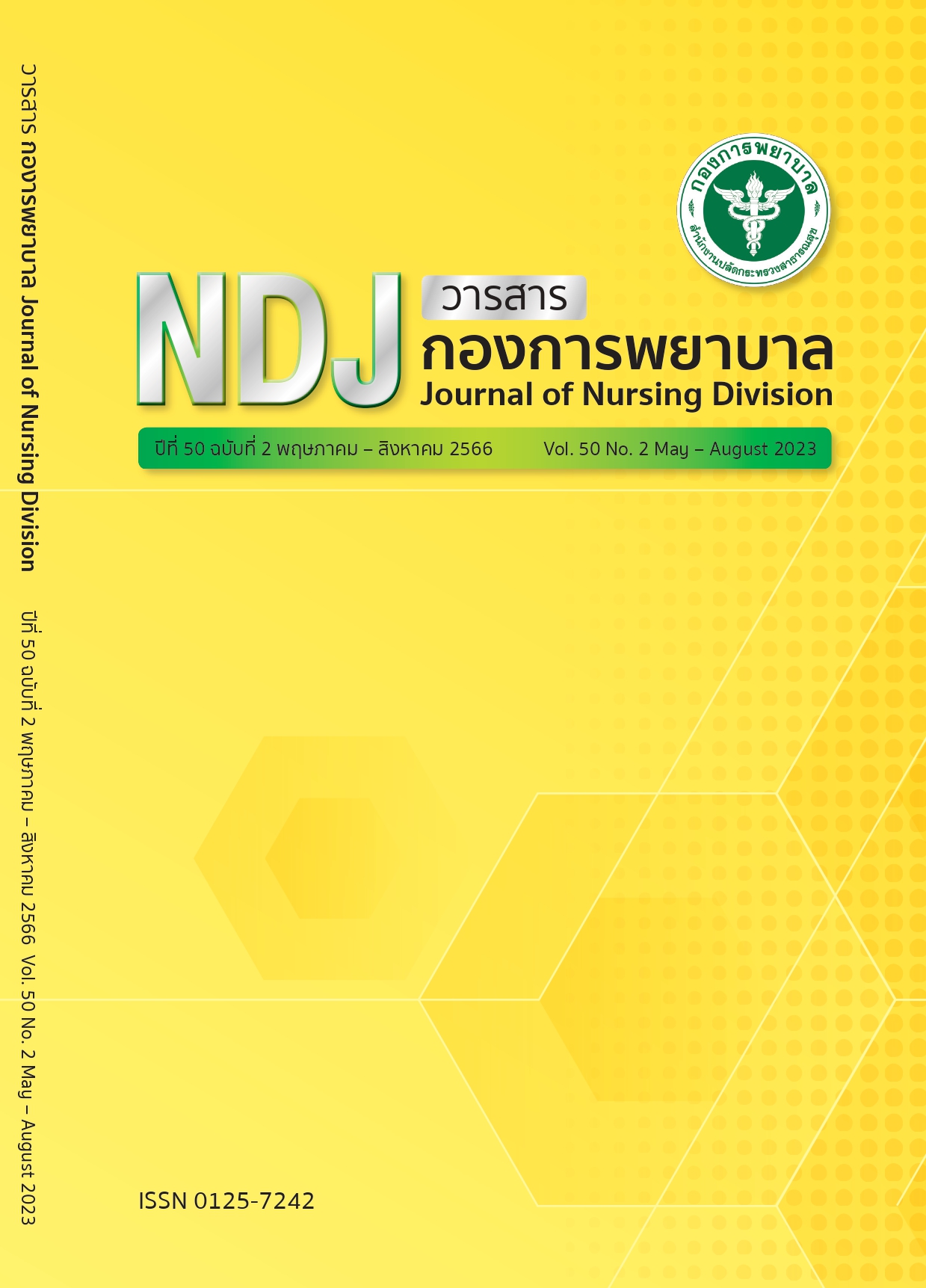Factors Associated with Clinical Symptom Deterioration in Sepsis Patients within 72 Hours Following Hospitalization
Main Article Content
Abstract
Abstract
This retrospective cohort study aimed to ascertain the frequency and contributing factors associated with the deterioration of clinical conditions in sepsis patients within 72 hours of their hospitalization. The study encompassed a cohort of 270 individuals diagnosed with sepsis at Lampang Hospital's Accident and Emergency Department and Inpatient Department. Data were extracted from medical records spanning September 2020 to August 2021. Research instruments included a patient-specific data record form, a health assessment record form, a patient care form, and a clinical deterioration assessment form. Content validity assessment were conducted by three experts, yielding a content validity index of 0.96. Analytical methods encompassed descriptive statistics and binary logistic regression.
The findings revealed that within the first 6 to 72 hours post-treatment, 53.70% of sepsis patients exhibited clinical deterioration. Worsening clinical symptoms primarily manifested within the circulatory, respiratory, nervous, and cerebral systems. The most substantial impact on symptom exacerbation was observed among patients admitted to the intensive care unit, resulting in a 2.69-fold increase in symptom deterioration (95% CI 1.16-5.05). Subsequently, the influence of underlying medical conditions and age were noted, with individuals having a single underlying condition experiencing a 2.42-fold symptom worsening (95% CI 1.16-5.05), those with multiple underlying conditions facing a 2.75-fold symptom aggravation (95% CI 1.30-5.80), individuals aged 65-79 undergoing a 2.19-fold symptom deterioration (95% CI 1.01-4.76), and those aged 79 years and older encountering a 2.23-fold symptom deterioration (95% CI 1.04-4.78).
Article Details

This work is licensed under a Creative Commons Attribution-NonCommercial-NoDerivatives 4.0 International License.
References
Reference
Rudd KE, Johnson SC, Agesa KM, Shackelford KA, Tsoi D, Kievlan DR, et al. Global, regional, and national sepsis incidence and mortality, 1990–2017: analysis for the Global Burden of Disease Study. The Lancet. 2020;395(10219):200-11.
Capp R, Horton CL, Takhar SS, Ginde AA, Peak DA, Zane R, et al. Predictors of patients who present to the emergency department with sepsis and progress to septic shock between 4 and 48 hours of emergency department arrival. Critical care medicine. 2015;43(5):983-8.
Indicator 34: Mortality rate of community-acquired sepsis patients [Internet]. 2020 [cited January 2021 ]. Available from: http://healthkpi.moph.go.th/kpi2/kpi/index/?id=1448. Thai.
Fleischmann C, Thomas-Rueddel DO, Hartmann M, Hartog CS, Welte T, Heublein S, et al. Hospital Incidence and Mortality Rates of Sepsis. Dtsch Arztebl Int. 2016;113(10):159-66.
Sakr Y, Jaschinski U, Wittebole X, Szakmany T, Lipman J, Ñamendys-Silva SA, et al. Sepsis in Intensive Care Unit Patients: Worldwide Data From the Intensive Care over Nations Audit. Open Forum Infect Dis. 2018;5(12):ofy313.
Quinten VM, van Meurs M, Wolffensperger AE, Ter Maaten JC, Ligtenberg JJ. Sepsis patients in the emergency department: stratification using the Clinical Impression Score, Predisposition, Infection, Response and Organ dysfunction score or quick Sequential Organ Failure Assessment score? European Journal of Emergency Medicine. 2018;25(5):328.
Quinten VM, van Meurs M, Wolffensperger AE, Ter Maaten JC, Ligtenberg JJM. Sepsis patients in the emergency department: stratification using the Clinical Impression Score, Predisposition, Infection, Response and Organ dysfunction score or quick Sequential Organ Failure Assessment score? Eur J Emerg Med. 2018;25(5):328-34.
Dugar S, Choudhary C, Duggal A. Sepsis and septic shock: Guideline-based management. Cleve Clin J Med. 2020;87(1):53-64.
Bunyaphatkun P, Sindhu S, Davidson PM, Utriyaprasit K, Viwatwongkasem C, Chartbunchachai W. Factors influencing clinical deterioration in persons with sepsis. Pacific Rim International Journal of Nursing Research. 2017;21(2):135-47. Thai.
Angkasekwinai N, Rattanaumpawan P, Thamlikitkul V. Epidemiology of sepsis in Siriraj Hospital 2007. J Med Assoc Thai. 2009;92(Suppl 2):S68-78. Thai.
Glickman SW, Cairns CB, Otero RM, Woods CW, Tsalik EL, Langley RJ, et al. Disease progression in hemodynamically stable patients presenting to the emergency department with sepsis. Acad Emerg Med. 2010;17(4):383-90.
Vardi M, Ghanem-Zoubi N, Bitterman H, Abo-Helo N, Yurin V, Weber G, et al. Sepsis in nonagenarians admitted to internal medicine departments: a comparative study of outcomes. QJM: An International Journal of Medicine. 2013;106(3):261-6.
Hall MJ, Williams SN, DeFrances CJ, Golosinskiy A. Inpatient care for septicemia or sepsis: a challenge for patients and hospitals. NCHS Data Brief. 2011(62):1-8.
RCoP L. National Early Warning Score (NEWS): standardising the assessment of acute-illness severity in the NHS. Report of working party London: Royal College of Physicians. 2012.
Martin-Loeches I, Guia MC, Vallecoccia MS, Suarez D, Ibarz M, Irazabal M, et al. Risk factors for mortality in elderly and very elderly critically ill patients with sepsis: a prospective, observational, multicenter cohort study. Annals of intensive care. 2019;9(1):1-9.
Michels EH, Butler JM, Reijnders TD, Cremer OL, Scicluna BP, Uhel F, et al. Association between age and the host response in critically ill patients with sepsis. Critical Care. 2022;26(1):1-16.
Sun GD, Zhang Y, Mo SS, Zhao MY. Multiple Organ Dysfunction Syndrome Caused by Sepsis: Risk Factor Analysis. Int J Gen Med. 2021;14:7159-64.
Wang HE, Weaver MD, Shapiro NI, Yealy DM. Opportunities for Emergency Medical Services care of sepsis. Resuscitation. 2010;81(2):193-7.
Flaatten H, Reinikainen M. Severity scoring, outcome prediction and mortality endpoints in intensive care. Acta Anaesthesiologica Scandinavica. 2015;7(59):819-21.
Yurkova I, Wolf L. Under-triage as a significant factor affecting transfer time between the emergency department and the intensive care unit. J Emerg Nurs. 2011;37(5):491-6.
Andersen RM. Revisiting the behavioral model and access to medical care: does it matter? Journal of health and social behavior. 1995:1-10.
Krejcie RV, Morgan DW. Determining sample size for research activities. Educational and psychological measurement. 1970;30(3):607-10.
McHugh ML. Interrater reliability: the kappa statistic. Biochem Med (Zagreb). 2012;22(3):276-82.
Wang HE, Jones AR, Donnelly JP. Revised National Estimates of Emergency Department Visits for Sepsis in the United States. Crit Care Med. 2017;45(9):1443-9.
Baykara N, Akalın H, Arslanta MK, Hancı V, Çalayan Ç, Kahveci F, et al. Epidemiology of sepsis in intensive care units in Turkey: a multicenter, point-prevalence study. Critical Care. 2018;22(1):93.


